How Lawn Mower Starter Works? The Ultimate Guide
by Lee Safin
A beautiful quote about mowing lawns
“We don’t really believe in mowing the lawn; we do it only to avoid unnecessary engagement with the neighbors.”
So, how lawn mower starter works?
A lawnmower starter is a small electric motor, which helps to start the motor. When you switch on the ignition key, the engine engages and begins to turn. Therefore, the engine will suck in air.
Whether it is a lawnmower or other automobile, no engine can start unless it has a significant amount of power.
So, how lawn mower starter works? The engagement of the flywheel is essential to start the mower. The battery plays a major role in sourcing the power and involves the flywheel. Then the crankshaft begins to spin, which is supported by the flywheel. Unless you press the solenoid button, you can’t switch on the starter motor.
In this article, we will share how lawn mower starter works in detail. Read until we finish to learn some precise information about it. Keep scrolling!
Contents

How Lawn Mower Starter Works?

After turning on the lawnmower mower ignition key, the engine starts to turn in motion and cranking. Do you think cranking is a simple process? No! It is a complicated process-not as easy as you think.
Unless there is the right level of air inside the engine, you will struggle to start it. No turn for the machine will occur if there is no airflow.
So, how does free airflow is achieved inside the engine? When the motor turns over and over, it creates suction. This helps to pass air inside the machine. If there is no air, the combustion of fuel won’t occur.
You can compare a lawnmower starter with a key of a locker. You are supposed to use the key to unlock the locker and then enter inside it.
After turning on the ignition key, the starter should work smoothly to turn over the engine. Only then can you start your lawnmower. When the starter works smoothly, you can do other things.
Lawnmower engines feature a flywheel that is mounted on the ring gear, and the crankshaft end is connected to it.
There is a pinion gear on the lawnmower starter, which is mainly located in the grooves of the ring gear.
The lawnmower starter receives energy after turning on the ignition key. The engagement of electromagnet also occurs.
A rod is pushed out from beneath the pinion gear that is connected to this. When the gear reaches the flywheel, the lawnmower starter will turn over.
As a result, the main engine will start spinning to collect air. Concurrently, spark plug wires convey electrical current to the plugs, and the combustion chamber receives fuel by the ignition process.
The starter disconnects once the engine is turned. Also, the electromagnet, which sends electricity through a coil of wire stops.
The rod pulls back into the lawnmower starter for another time to keep out of reach between the flywheel and the pinion gear.
If there is any connection between the pinion gear and the flywheel again, a rapid engine spin for the starter will occur. It will ultimately cause damage to the starter.
So, this is the way how lawn mower starter works. Knowing the mechanism gives an entire idea of each part of starter functions and how they contact each other.
How To Bypass the Starter Solenoid?

Apart from knowing how lawn mower starter works, it is essential to understand how to bypass the starter solenoid.
Are you getting a clicking sound from your lawnmower but failing to start the lawnmower? The problem might be related to the starter solenoid or starter motor.
So, why does this happens? It mainly occurs when the starter solenoid is attempting to push for the engagement of the lawnmower machine. But, it may not happen if the starter solenoid doesn’t have enough power to move the gear for engagement. Also, the issue may seem if the starter solenoid becomes excessively cold.
One of the best methods to deal with this issue is by bypassing the starter solenoid. Wondering how to bypass the starter solenoid? Check out this step-by-step procedure to learn about how to bypass the starter solenoid.
Step 1 — Checking The Battery
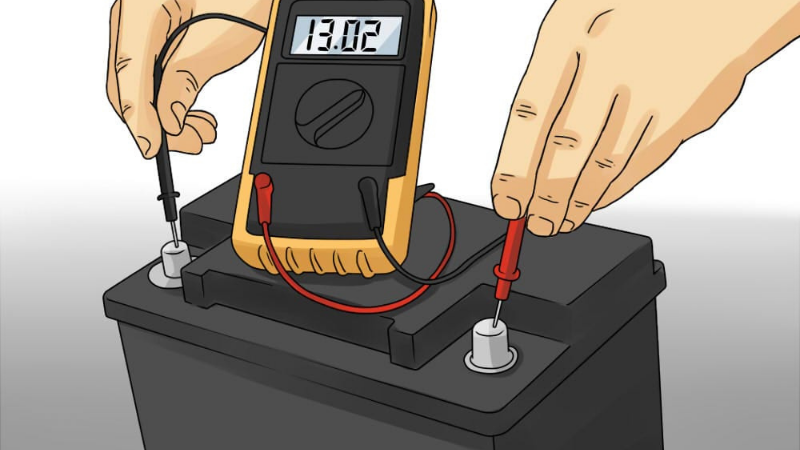
First of all, you want to test the battery conditions whether it is working perfectly or not. You can use a multimeter or a battery tester to test it. The battery is supposed to read 12v if no issue with it. If it is okay, follow the next steps.
Step 2 — Switching On The Ignition Key
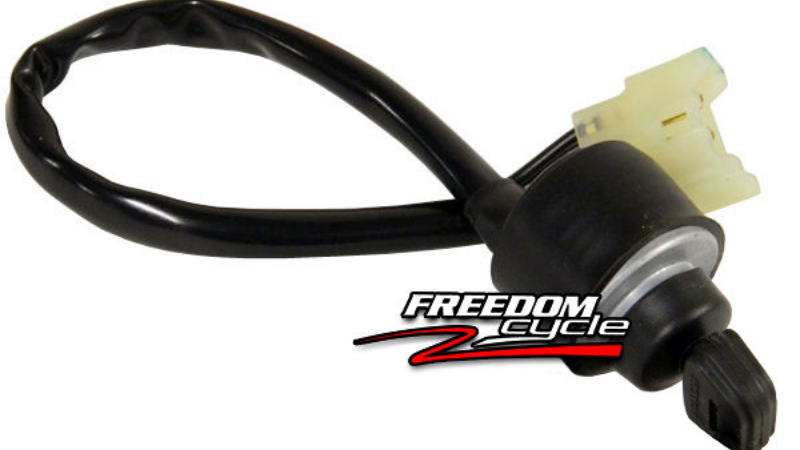
Try to turn on your lawnmower by pressing the “START” button. Despite receiving power, sputter would not begin
Now, you want to keep the ignition in the “RUN” option. By doing so, you allow the battery’s current to pass through the circuit.
Step 3 —Finding Out The Lawnmower Solenoid

Give your hands on the battery, which is mainly located below the mower seat. Now, find out the cable which is connected with the positive terminal. A cylindrical structure is attached to the positive terminal and has three or four wires connected.
Lawnmower solenoids either come with three-pole or four-pole. Common ground is connected to the three-pole solenoid, which is mounted on the mower. On the other hand, a special terminal is included for the ground on four-pole solenoids.
Step 4 — Identifying The Copper Posts

Two big terminals are equipped for a lawnmower solenoid, and each of them has large cables connected to them. One cable is connected to the battery’s positive terminal while the other one goes to the motor. In this case, these two huge
are what we are looking at.Step 5 — Cleaning The Terminals
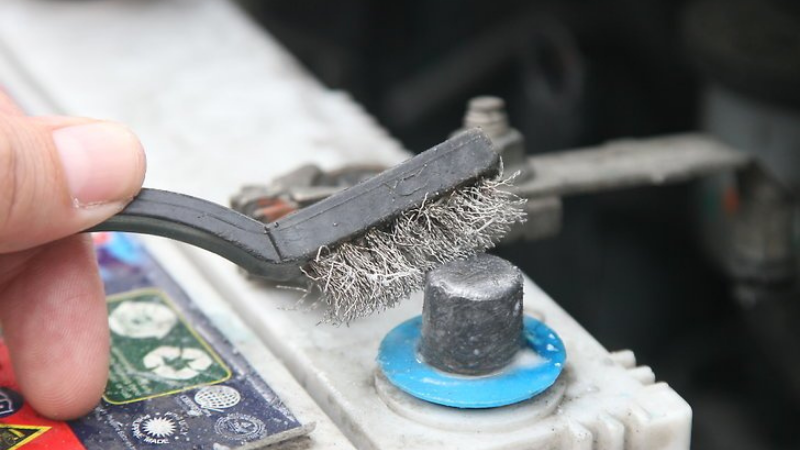
Rust and dirt may store inside the terminals. You want to use a wire brush to get rid of them from inside and outside.
Step 6 — Giving A Final Finish
Now, you want to attach the positive terminal from the battery to the motor using a screwdriver. A complete circuit can be built this way, and the lawnmower will then start.
So, these are the complete steps of knowing how to bypass the starter solenoid.
What Are the Symptoms of a Bad Starter Motor on a Riding Mower Engine?
A riding mower engine is supposed to start smoothly if there is no issue with the starter motor. However, if there is an issue, you may struggle to start it or stop within seconds after running. What are the symptoms of a bad starter motor on a riding mower engine?
Here are the few common signs you will notice if you are wondering about,” What are the symptoms of a bad starter motor on a riding mower engine?”
1. Defective Battery


Is the lawnmower battery working perfectly? Does it produce a sufficient amount of voltage? To learn about it, you want to use a battery tester or a millimeter to find out the voltage it is generating.
Each lawnmower battery must have enough voltage to help the starter motor to start the engine. If it doesn’t have enough voltage, you want to recharge or replace the battery.
2. Clean Leads
Clean leads are necessary for the positive and negative wires, which are connected to the battery. With dirty leads, your lawnmower won’t be able to make nice electrical contact.
Make sure you regularly remove any corrosion or dirt from the cable clamps or battery posts using a wire brush.
3. Spark Plugs Issues


Have you checked the spark plugs of your lawnmower? They need regular cleaning for smooth operation. Check out any wear or fouling on spark plugs after removing the wires connected with them.
Carbonized or oily spark plugs can be the reason behind a bad starter motor. If your spark plugs are oily, it means piston rings already got damaged. Hence, changing spark plugs will not solve the problem unless you replace the piston rings.
However, replacing is a better option if you notice any wear or damage issues on the spark plugs. Start your lawnmower to see whether the lawnmower is working perfectly or not.
4. Functioning Starter Solenoid


A place between the starter and the battery is where the starter solenoid is located. It is a special switch. When you turn on the button, electric power is transferred to the starter motor to run the lawnmower engine.
So how do you test whether your starter solenoid is bad or good? After turning on the ignition key of your lawnmower, the starter solenoid jump. And, at the same time, closing the space between the two bolts on the solenoid will help you know the starter solenoid’s conditions.
While doing the test, if the engine runs, you might have a bad solenoid. Replacing it is necessary. However, the starter motor might be the main culprit if you fail to start the engine.
So, these are primary symptoms you will see to learn about “What are the symptoms of a bad starter motor on a riding mower engine?”
How To Start A Lawn Mower With A Bad Starter?
It is difficult to start your lawnmower with a bad starter. Various problems cause the starter to fail frequently. Here are the few common issues you may see if your lawnmower has a bad starter.
| Serial No | Causes |
|---|---|
| 1 | Defective Starter Motor |
| 2 | Defective Battery |
| 3 | Defective Ignition Switch |
| 4 | Defective Solenoid |
1. Defective Battery


Cutting grass with a defective battery is not an easy job. The first thing you want to do checking if any leakage issue on the battery.
So, why leakage occurs on the battery? Most of the time, it happens when water enters inside the battery.
You can first try out sealing leaks of the battery. If it doesn’t work, you have no option but to replace it. Keep your hands and eyes safe by putting on gloves and safety eyewear when working with batteries.
Further, you want to assure the battery has a considerable amount of charge. If not, you want to use a charger cable to recharge the battery.
Aside from that, testing the battery voltage is another essential job you need to do. When it reads 12 volts on the tester, you can take it as a good battery. The battery is likely to have a problem if it doesn’t work.
2. Defective Solenoid


If this is your first time locating a starter solenoid, you may find it challenging. You will either have to reach it by raising the front hood in the upper level or the rear wheel.
Follow the red wire on the battery if you are facing difficulty reading the directions. After finding the solenoid, inspect the conditions of the terminal attacher and screws that are connected with the solenoid. Tighten the screws if they are loose. But not overtighten them. Also, inspect the attacher.
Next, you want to turn on the lawnmower keys in the clockwise direction. Do you hear a clicking sound though the engine is not starting? If yes, replacing the solenoid is necessary.
3. Defective Ignition Switch


A defective ignition switch can sometimes cause a bad starter. By looking at the switch’s internal conditions, you can tell whether it is in good condition or not.
Inspect the switch from the backside and lower area. Make sure all wires attached with the switch are properly connected—no loose issues. Also, check out if there is any corrosion buildup inside it.
The ignition switch is often to blame for the problem with the starter if it is found to be defective. Replacing the ignition switch will help to deal with the issue.
4. Defective Starter Motor


You will struggle to run on your lawnmower if any issue occurs on the starter motor. Put your hands under the front hood, where you will notice the starter motor.
Typically, the starter motor and solenoid are connected together in the lawnmower. Take a jumper (a short length of the conductor) and connect the negative end with a screwdriver and the positive end with the jumper of the batter.
You are supposed to notice some sparks after attaching the screwdriver with it. You have no reason to fear a shock because 12 volts are not powerful enough to give you a shock.
If you notice the lawnmower is not starting even though you hear clicking sounds, replacing the starter motor is the best solution.
Warning
- It is the best rule of thumb to read all instruction manuals of each lawnmower part before starting the work. You will get a clear overview of them.
- Make sure you wear high-quality hand gloves and eye wears to protect your hands and eyes.
- Wearing a protective cloth is also appreciable if any unwanted accidents happen.
- Make sure you know how to use the screwdriver and multimeter.
- Kids should be away while doing the work.
Hopefully, you have learned about “How to Start a Lawn Mower with a Bad Starter?”
How To Replace A Lawn Starter? Step By Step
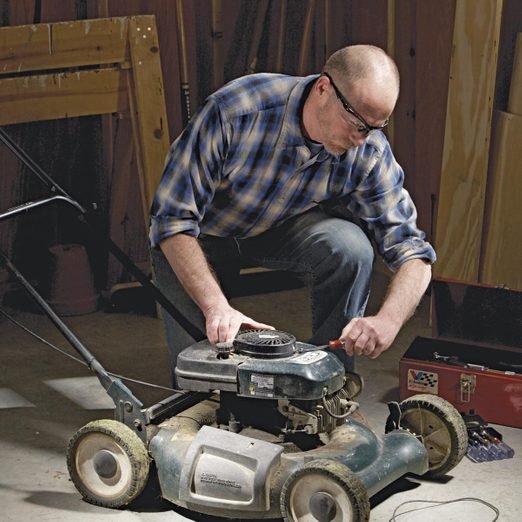
Apart from knowing how lawn mower starter works, it is also important to get an idea about how to replace a lawn starter.
Does your lawnmower have a problematic starter? When you try to start your lawn mower, all you hear is a grinding noise.
If your lawnmower starter has a problem, it will not appear to be engaging the flywheel. That’s the main issue with the starter.
Also, you may see the gear is stuck in the up position; there’s totally something wrong with that. Once the switch is off, that gear should be all the way back down. Additionally, the collar may not slide back down the shaft.
The most common reasons gardeners replace starters on the lawn are because they are burned out. People hold them way too long when the machine won’t start. This makes the starter overheat, and then eventually, it becomes completely damaged.
Step 1 – Disconnect Your Negative Cable
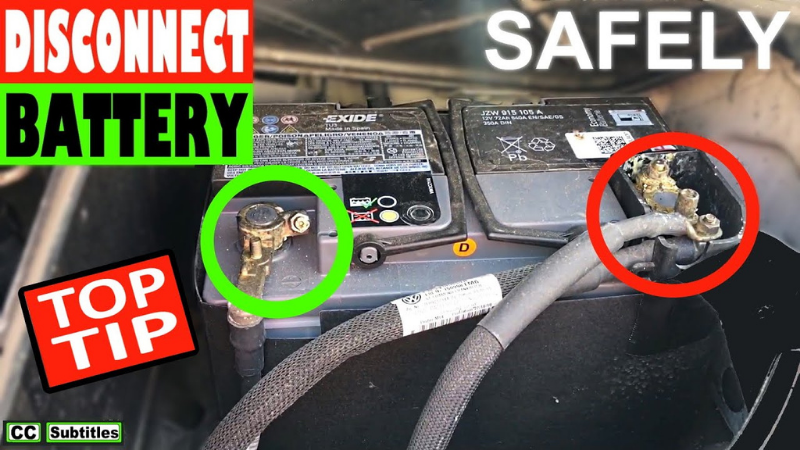
First of all, your negative cable needs to be disconnected from your battery. You are disconnecting the battery cable is for safety purposes as you don’t want a live positive wire.
Once you take it off at the starter dangling and touching the mower’s body, that would definitely cause sparks and a short. Next, you want to remove the positive battery cable here from the starter.
Step 2 – Put a Bit of Loctite


It is better to put a bit of Loctite on the bolts that hold the starter. You can use medium-strength Loctite, which makes the starter easy to install. You just line it up to the two holes underneath the starter and serve your bolts.
If your holes aren’t quite lined up properly, just move the starter a bit to get it in and install the bolts evenly. Make sure they are tightened fairly.
Step 3 – Install The Positive Battery
Then, install the positive battery cable on the starter and undo the nut. Before reconnecting the battery cable, it’s best to clean the posts and get rid of corroded bolts. With a wire brush and a drill, you can clean it.
Now you can add a bit of dielectric grease on the posts if you want. This will help prevent corrosion. So, removing and installing a new lawnmower starter is done. Now you can try to start the mower.
Wrapping Up
Are you still wondering how lawn mower starter works? We have already covered everything about this topic. Hopefully, you have learned many precise details on how lawn mower starter works. Thanks for reading!
Last update on 2023-01-28 / Affiliate links / Images from Amazon Product Advertising API
 |
 |
 |
 |

About Lee Safin
Lee Safin was born near Sacramento, California on a prune growing farm. His parents were immigrants from Russia who had fled the Bolshevik Revolution. They were determined to give their children a better life than they had known. Education was the key for Lee and his siblings, so they could make their own way in the world. Lee attended five universities, where he studied plant sciences and soil technologies. He also has many years of experience in the U.S. Department of Agriculture as a commercial fertilizer formulator.
Thoughts on "How Lawn Mower Starter Works? The Ultimate Guide"
 |
 |
 |
 |
Gardening Stuff
Get FREE Gardening Gifts now. Or latest free toolsets from our best collections.
Disable Ad block to get all the secrets. Once done, hit any button below
 |
 |
 |
 |